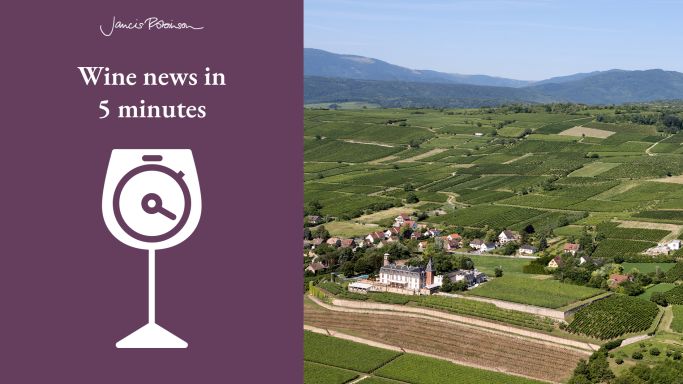Plus a brazen wine fraud case, the bankruptcy of a major California company and potential sale of Gusbourne in England, the wrap-up of Ontario’s LCBO strike and more damaging weather in France. Above, Alsace's Vorbourg vineyard at the base of the mountains.
I have a heap to get through this week! But before we get going, I feel it is my duty as a US wine consumer to let you know that US Dietary Guidelines for alcohol are due to be updated in 2025. The Interagency Coordinating Committee on Preventing Underage Drinking – who for some inexplicable reason is in charge of conducting the research that will inform the new guidelines – published their proposed protocol for research at the beginning of this month. The deadline for public comment is next Friday 2 August. As of this morning the link for public comment had been clicked only 478 times – and ten of those were me. If you have a vested interest in this research being done with as little bias as possible, I highly recommend you read the protocol and submit comments!
Ontario strike wraps up
For the last two weeks, more than 9,000 Liquor Control Board of Ontario (LCBO) employees belonging to the Ontario Public Service Employees Union (OPSEU) have been on strike, resulting in the closure of 669 stores across the province and severely hampering the ability of restaurants and privately operated liquor stores to keep product in stock.
On Monday 22 July the union and the LCBO ratified a new three-year agreement and on Tuesday LCBO stores reopened.
There’s ongoing debate as to whether expanded privatisation of alcohol sales will result in the diminishment of the LCBO but, at least for the time being, the strike has ended, and Ontarians can resume shopping for alcohol as usual.
New Pinot Noir grand cru for Alsace
Until 2022, Alsace limited its 51 Grand Cru appellations to five white-wine grapes. That year they added Pinot Noir to the list of allowed grapes in the grands crus of Kirchberg de Barr and Hengst. On 4 July of this year they agreed to add Pinot Noir to the Grand Cru Vorbourg.
This may seem a little thing, but I think it’s really important to recognise that the AOC system, France’s strict system for regulating the use of geographically-based names which is often criticised for its rigidity, is, in fact, willing to process changes that will be necessary with a changing climate. In two years, the number of Alsace Grand Cru red wines has gone from 0 to 3!
Champagne yield limits cut
Every year, the Comité Champagne sets the yield limits for the year’s harvest based on weather and market conditions.
On 19 July the Comité Champagne announced that the authorised yield has been cut 12% compared with last year – from 11,400 kg/ha to 10,000 kg/ha. While conditions have been dreary and rainfall has been high, the reason for the cut has more to do with the fact that shipments of champagne in the first half of 2024 were down 15.2% over 2023. So, in essence, the governing body is forcing reduced production to keep from creating an oversupply.
Please feel free to rage against artificial limitations in the forum or comments but, for my part, I’m currently wishing there were more systems that legally regulated yield to protect quality, product value and, ultimately, producers and their staff members. It would be excellent if the end goal weren’t always endless growth. And perhaps if that was the case my next piece of news wouldn’t be bankruptcy. But it is …
Vintage Wine Estates declares bankruptcy
On 24 July Vintage Wine Estates, the eleventh-largest US wine company by cases sold in 2023, announced that it was filing for Chapter 11 bankruptcy. The cause was overexpansion, debt – to a tune of $310 million – and a grape surplus according to a Reuters report.
If you haven’t heard of Vintage Wine Estates, the company owns BR Cohn, Cameron Hughes, Cherry Pie, Clos Pegase, Cosentino, Kunde, Layer Cake, Owen Roe, Qupé and many more.
As of Wednesday, they have voluntarily delisted their stock and plan to sell all assets to pay off debt. Last week they completed the sale of Cosentino Winery for $10.5 million.
This is heart-wrenching but it’s also fairly predictable. Relying on endless growth is not sustainable.
Gusbourne’s potential sale
A month ago, I talked about the expansion of UK vineyards by 123% in the last decade paired with a global downturn in wine consumption, and WineGB declaring 2024 the ‘year of growth’. Well, growth costs money. And as it turns out, investors are less keen to continue funding growth when the overall market is unstable. Last September Hambledon Vineyard sold to Berry Bros and Rudd and Symington due to a deteriorating financial position. A month ago, Chapel Down announced they were considering a sale in order to fund expansion. And on 22 July, Gusbourne announced that its majority stakeholder, Lord Ashcroft, was considering a potential sale. Looking at Gusbourne’s 2023 year-end financial review, they’ve been operating at a loss for at least the last five years.
Our Members’ forum currently has a discussion going under ‘English wine – the problem of price’ and English wine producer Andrew Matthews and Purple Pager Robert Stanier have made some pretty compelling points on why the UK may be overshooting its growth potential.
Damaging rain and hail in Sancerre
French publication Vitisphere has reported that on Saturday 20 July Sancerre received damaging levels of rain. They quoted Guillaume Laporte, president of the federation of Independent Winegrowers in the Centre Val de Loire, as saying, ‘On Saturday evening, we all received between 40 and 90 mm of rain in 20 minutes. It's the second time in 10 days.’ Parts of the region were also hit by hail. This is after an already challenging, cool season with rampant fungal pressure.
A wild wine fraud case
The publication Vino Joy reported this week that billionaire Wood Chen has been connected to a billion-dollar fake-wine scandal in Taiwan (equivalent to around $30.5 million USD or £23.7 million sterling). Many of the bottles sold by Wood Chen were sold through Top 100 Wine. The fraud seems to be fairly blatant with hundreds of bottles sold to single collectors from producers who release only a few hundred bottles a year, corks whose year doesn’t match the label and wines from vastly different vintages that somehow look and taste exactly the same.
But what makes this more interesting is that Wood Chen is the brother of Pierre Chen whose ‘Epicurean’s Atlas’ wine collection – reported to be the largest and most expensive wine collection ever offered at auction – is in the midst of a year-long auction series put on by Sotheby’s.
Old Vine Registry update
Thanks to our California-based correspondent Alder Yarrow, the OVR – a crowdsourced global database of old-vine vineyards – has a new feature in which, if you scroll to the bottom of the home page, you can now search for old-vine vineyards by grape variety. Go check it out!
This is a transcript of our weekly five-minute news broadcast, which you can watch below. You can also listen to it on The Wine News in 5 Podcast. If you have breaking news in your area, please email news@jancisrobinson.com. And if you enjoy this content and would like to see more like it, please subscribe to our site and our weekly newsletter.
Photo at top of Alsace's Vorbourg by ZVardon courtesy Vins d'Alsace

